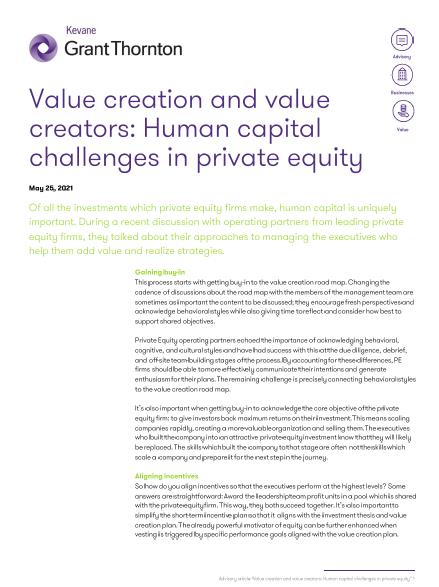Gaining buy-in
This process starts with getting buy-in to the value creation road map. Changing the cadence of discussions about the road map with the members of the management team are sometimes as important the content to be discussed; they encourage fresh perspectives and acknowledge behavioral styles while also giving time to reflect and consider how best to support shared objectives.
Private Equity operating partners echoed the importance of acknowledging behavioral, cognitive, and cultural styles and have had success with this at the due diligence, debrief, and off-site team-building stages of the process. By accounting for these differences, PE firms should be able to more effectively communicate their intentions and generate enthusiasm for their plans. The remaining challenge is precisely connecting behavioral styles to the value creation road map.
It’s also important when getting buy-in to acknowledge the core objective of the private equity firm: to give investors back maximum returns on their investment. This means scaling companies rapidly, creating a more valuable organization and selling them. The executives who built the company into an attractive private equity investment know that they will likely be replaced. The skills which built the company to that stage are often not the skills which scale a company and prepare it for the next step in the journey.
Aligning incentives
So how do you align incentives so that the executives perform at the highest levels? Some answers are straightforward: Award the leadership team profit units in a pool which is shared with the private equity firm. This way, they both succeed together. It’s also important to simplify the short-term incentive plan so that it aligns with the investment thesis and value creation plan. The already powerful motivator of equity can be further enhanced when vesting is triggered by specific performance goals aligned with the value creation plan.
Key metrics typically go beyond EBITDA to a more balanced set of metrics which could include bookings, revenue, and growth. Because there is a natural offset between revenue growth percentage and EBITDA, a goal which combines the two often works well.
Of course, one key to managing the best executives is to not overmanage them. Participants believed in letting good teams do what they are best at. At the same time, the founding executives should have regular communication with the private equity firm and access to resources who can help them navigate the new water they’ve entered.
The board is key here. One emerging best practice is to have board members who can confidently and successfully lead in an executive capacity but who are not necessarily looking to fill a role in day-to-day leadership. This provides a ready successor without having current leadership feel like they have someone hoping that they fail. Instead, they can show by example what next level leadership looks like and also be prepared to step into a role very quickly, if a need does in fact arise.
Defining nonfinancial metrics
- discuss with firms and other PE firms about defining what a baseline might be to determine what “good” is
- initiating affinity groups across their holdings, to help define issues, formulate metrics, gather data, identify leaders, and suggest best practices to iterate the data so it is meaningful
- firms which do business internationally face additional challenges as inclusion contrasts in different parts of the world
Making transition decisions
Transition decisions are some of the hardest ones a private equity firm has to make.
The idea that one CEO is the right fit at all stages of development is increasingly outmoded. To facilitate that understanding, transparent conversations are important. Participants found that CEOs themselves do not want to be in a position they are no longer suited for and, if the decision is properly and respectfully communicated, they will often provide invaluable transition assistance. In some ways, the level of executives below the CEO may be more a difficult challenge, but the same principles of promptness and transparency still apply.
It’s important to develop candidates in advance and, if possible, familiarize them with the specifics of the acquired company.
Finally, traditional succession planning should not be overlooked. This gives both the board and management team confidence that the company will be in good hands—that the value creation plan introduced during the acquisition will, in fact, be realized. And that benefits all stakeholders.
Source: Grant Thornton library articles

